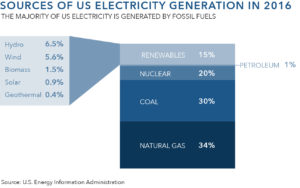Economic Foundations
Food, energy, water, and physical security are the most essential human needs. At the base level, societies and governments exist to create and manage enduring structures to satisfy those needs. Although much of the world has advanced past the stage where we still struggle to satisfy these needs, the foundational structures of societies are tied to food, energy, water, and physical security.
Because of the foundational nature of this relationship, any changes to the technology, availability, and application of these core needs will have far-reaching structural impacts. Focusing specifically on energy, significant change to the source, storage, and distribution of power is a catalyst that will have widespread disruptive effects. These effects will not only impact the companies that operate in the energy and natural resource industries but also other industries and public institutions that rely on energy — in other words, nearly everything.
Grayline is therefore intensely focused on energy technology. While we are well into the mature phase of the hydrocarbon/internal combustion era and don’t expect a wholesale shift in the near term, there are some interesting developments that we believe have the potential to change the mix of energy sourcing and production.
The emerging power source is the broad category of renewables, which encompasses solar, wind, and hydro power, among other sources. However, the technologies we are focused on are not necessarily the specific renewables, as these technologies have generally reached a level of minimum maturity in order to be effective. Instead, we are focused on battery technology, which we view as the remaining piece of the puzzle of economic viability for renewables. Current grid storage battery technology is not efficient or cost-effective enough to enable renewables to truly compete with traditional energy production.
Battery technology is rapidly developing, due in part to the investments and advances companies such as Tesla have made to support electric cars. Next-generation battery technology that overcomes the constraints of current lithium-ion models will have a far-reaching impact, specifically when they scale to grid storage capacity.
The economic viability of some forms of renewable energy will be drastically increased by effective grid storage technology, which facilitates the localization of energy production and consumption. Batteries are the key, and they have the potential to change the shape of global energy production, storage, and consumption.
Renewables
Even when power generation costs reach parity between renewables and hydrocarbons, the latter will remain the lower-cost option because of the massive infrastructure investments that developed countries have made over the past generations. Renewables must be significantly cheaper to overcome switching costs. Combined with enhanced battery storage capabilities, some of these cost savings will result from dramatically reduced transportation costs.
Localizing power generation and power consumption removes most of the infrastructure-heavy transportation requirements featured by hydrocarbons. It is possible that developing countries that have not yet invested in hydrocarbon-based energy infrastructure never will.
To understand the evolution of the energy sector, we must evaluate both power generation and power storage technologies, both of which have progressed significantly in the last decade. Solar energy specifically has experienced significant gains, but wind, hydro, and other sources have also seen efficiency gains and cost reductions.
Solar
The solar industry has undergone remarkable growth in the last decade, due to both efficiency increases and cost reductions of photovoltaic (PV) cells, the core of solar technology.
The global solar PV capacity has grown from around 5 GW in 2005 to approximately 230 GW in 2015. In 2006 it cost $9 per watt of power generated by solar panels. As of 2015 that figure had dropped to approximately $3.79 per watt, and is reported to be around $3.57 per watt as of late 2016.
According to the Solar Energy Industries Association, the US-based solar industry has grown at a 60% compound annual growth rate over the past ten years. It employs nearly 209,000 Americans, twice as many as in 2010. As of February 2016 over 1 million homes in the United States have installed solar panels.
Wind
Wind power generation has also experienced significant growth. The global installed capacity of wind power generation grew from approximately 59 GW in 2005 to 432 GW in 2015. The levelized cost of wind power has dropped by an average of 7% per year since 1985, an overall cost reduction of over 90% during that period.
Wind is increasingly becoming an important part of the power generation mix, especially in Europe. Denmark generates approximately 40% of its electricity demand via wind power. Wind has a 20% penetration in Portugal, Spain, and Ireland, and has reached 5.6% in the United States.
Material sciences as well as blade and tower design will continue to provide efficiency gains and cost reductions for wind power. At the simplest level, taller towers are more productive and allow greater geographic coverage of onshore wind turbines. General advances in manufacturing and construction technology and techniques benefit the wind power industry directly, as do materials that allow for lighter turbines.
Other Growth Areas
Geothermal, hydro, and other sources of renewable energy have also grown in recent years. The technologies that enable all categories of renewables will continue to make strides in upcoming years, but the developments of the past decade have generally brought them to a level of minimum technological viability. These technologies are ready for mainstream, and in many cases are being used very effectively around the world.
The remaining hurdle is a power storage solution to offset the inherent variability of renewables that depend on sun or wind. When storage solutions become cost-efficient at scale, we anticipate a dramatic increase in the fundamental economics and use of renewables.
Source: GWEC, SolarPower Europe
Batteries
As batteries are the critical path towards the significant expansion of renewable energy production and use, we must understand the current state and imminent future of battery technology. Electric vehicles have created an important incentive towards advances in battery technology. Companies such as Tesla and others have invested billions in battery research to increase the range of electric cars. Without this economic incentive, battery research had been relegated to “special project” status within companies. Now the success of important companies depends on advances in battery technology.
The public sector has also been involved in funding research and development efforts. The 2009 US stimulus legislature included $2B in grants for manufacturing advanced batteries, along with tax credits to cover 30% of the cost of a manufacturing plant, bringing the total direct investment in batteries to $2.4B. The same legislation also included $7.5B in loans authorized for advanced vehicle manufacturing technology and $16.8B for energy efficiency and renewable energy, all of which include battery technology.
Both public and private sector research efforts have resulted in increased efficiency and lower cost. The lithium-ion battery, the current standard for both electric vehicles and consumer electronics, has gained significantly. There are three basic parts to a battery: two terminals called the anode and the cathode, and the electrolyte that separates the terminals. Rechargeable lithium-ion batteries traditionally use a lithium metal oxide for the cathode, and a graphite layer for the anode, a design that has proven to be extremely effective but is reaching its limits as other technologies advance.
Source: Credit Suisse, Tesla
Source: Credit Suisse, Tesla
The general goal for battery development is to increase energy density at the same or longer lifetime while reducing cost. Energy density for size-efficient batteries is extremely important for electric vehicle development, while cost and storage capacity are more important for grid storage batteries. Increases in all of these areas are possible with lithium-ion technology, but researchers are also focused on new materials.
Within the lithium family, researchers are exploring lithium-air, lithium-sodium, lithium-metal, and solid-state lithium-ion technologies. Lithium-air batteries, for example, would use oxygen as the oxidizer, drastically reducing cost and increasing longevity. Beyond lithium, there have been advances in magnesium, aluminum-air, and sodium-ion batteries, as well as graphene supercapacitors, microbatteries, and a number of other developments.
We may see battery technologies branch between those that are most applicable to vehicles (higher energy density) and those better suited for grid storage (lower cost per capacity). For example, chemists at the University of Waterloo have developed zinc-ion batteries that are long-lasting, safe, and cost half the price of current lithium-ion batteries. Zinc-ion batteries tend to be large and have lower energy density than lithium-ion batteries, but could have potential grid storage applications due to their cost and safety.
Broad Structural Effects
Next-generation batteries will facilitate the economic viability of certain types of renewable power generation. Some researchers estimate that energy storage at less than $100 kWh would produce a galvanizing effect, incentivizing broad adoption. We may be nearing this milestone in the next few years.
RW Baird estimates that Tesla’s current battery costs are between $150-$200 kWh, well ahead of the industry average estimated by Bloomberg New Energy Finance to be around $350 kWh. Regardless of when researchers achieve $100 kWh or what exactly galvanizes broad adoption, the change will be transformative for a variety of industries. Economically viable renewable power generation has several structural impacts beyond the obvious effects to hydrocarbons producers and importers.
Changing Shapes of Cities
Traditional power grids are large, because they operate in a fashion that requires economies of scale. Power generation plants are typically expensive, so it is most cost efficient to build large facilities, supporting a large grid of power consumers. The result is that traditional power grids favor centralized, dense environments.
Renewable power generation facilities tend to be far less expensive than traditional facilities. Hydropower plants that require large dams are an exception, but solar and wind facilities are relatively inexpensive and have a far smaller footprint than traditional power plants.
Lower cost power generation and effective grid storage batteries would allow power grids to decentralize, yet still be cost efficient. It becomes economically viable to localize power production, storage, and consumption. In effect, we could disaggregate the grid.
There are a number of reasons people live in large cities. The shape and composition of power grids is one of many factors, and likely not the driving factor. However, it is interesting to think about shape and physical footprint of cities and entire societies as different city planning structures are enabled. This could affect how and where people live, which is critically important to companies and government agencies across the spectrum.
Changing Global Trade
The United Nations estimates that approximately 21% of the value of global trade in 2013 consisted of natural resources. The remaining categories were manufacturing (68%) and agriculture (11%). While natural resources is a broad category that includes more than just energy products, it is safe to say that energy-related resources constitute a meaningful portion of global trade and shipping volumes.
Renewables combined with effective grid storage technology allows for the localization of power generation and consumption. Correspondingly, the countries that adopt renewable power-generation technologies will require fewer energy resources to be shipped or otherwise transported to them from other places in the world.
Widespread adoption of renewables would be extremely disruptive to the energy shipping and logistics industries, but even moderate levels of adoption will impact these companies. Shipping companies, for example, are highly capital-intensive businesses. They operate at thin but generally positive margins by allocating their fixed costs (i.e., ships) across the price of a broad base of shipped goods. If the amount of shipped goods decreases, even marginally, but the fixed costs remain constant, this becomes a problem for the industry.
Political Dynamics
As energy security is closely correlated with national security, there is also a geopolitical component to renewables. Countries that rely on imports to satisfy internal energy demand are fundamentally exposed, and to some degree reliant, on exporters. Energy exporters use price-and-supply favoritism as political tools to extract political concessions as a matter of course.
There are countries whose entire foreign policy rests on these mechanisms. Conversely, there are countries exposed to those machinations from their neighbors who would significantly benefit from any degree of increased control over energy supply.
These effects, and many others we haven’t discussed here, demonstrate how important energy technology is, why we consider it a catalyst, and how far-reaching and global the ramifications of even slight changes will be.
Source: BP
Join the Catalyst Monitor
Join our community, where we push out regular insights to help maintain situational awareness on technological and socioeconomic trends.




